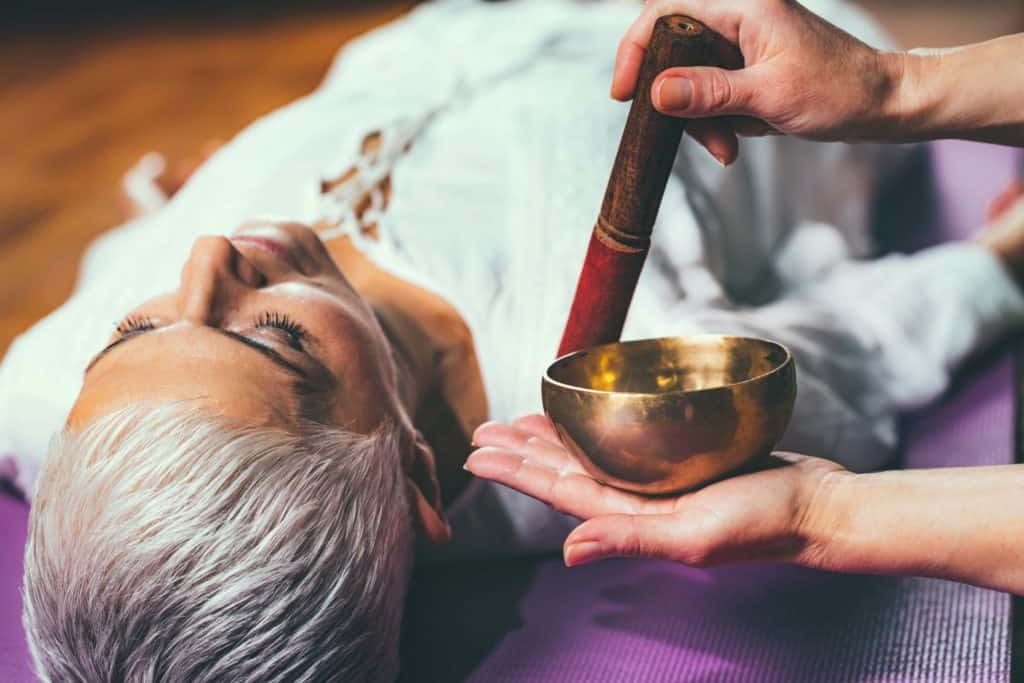
The Surprising Benefits of a Sound Bath
The surprising benefits of a sound bath – have you ever heard of it? This ancient practice, rooted in healing traditions around the world, involves immersing yourself in a symphony of sound vibrations. Imagine a room filled with the resonant hum of singing bowls, the gentle chimes of tuning forks, or the deep, resonating tones of gongs.
It’s more than just listening – it’s about experiencing sound as a powerful force that can profoundly impact your well-being.
Beyond the calming ambiance, sound baths offer a range of benefits, from stress reduction and improved sleep to enhanced creativity and emotional balance. Whether you’re seeking a moment of tranquility or a path to deeper self-discovery, sound baths offer a unique and transformative experience.
What is a Sound Bath?

A sound bath is an immersive, meditative experience that uses sound frequencies to induce relaxation, promote healing, and enhance well-being. It has roots in ancient healing traditions around the world, where sound was used for spiritual and therapeutic purposes.The practice of sound baths has gained popularity in recent years as a holistic approach to wellness.
It involves lying down comfortably, often in a dimly lit room, while a practitioner plays various instruments that produce soothing and resonant sounds. These instruments can include singing bowls, gongs, chimes, drums, and other instruments that create vibrations that resonate throughout the body.
The Role of Sound Frequencies and Vibrations
Sound baths work by leveraging the power of sound frequencies and vibrations to influence the body’s natural state of relaxation and balance. Each instrument produces unique sound frequencies that interact with the body’s energy field, known as the aura. These vibrations can create a sense of deep relaxation, reduce stress, and promote a sense of well-being.The human body is composed of approximately 70% water, which is highly receptive to vibrations.
When sound waves enter the body, they interact with the water molecules, causing them to vibrate. This vibration can affect various bodily systems, including the nervous system, the endocrine system, and the circulatory system.
“Sound is a powerful force that can be used to heal, transform, and elevate consciousness.”Dr. Mitchell Gaynor, author of “The Healing Power of Sound”
Relaxation and Stress Reduction
Sound baths are known to have a profound impact on our nervous system, leading to relaxation and stress reduction. The rhythmic and calming sounds of instruments like singing bowls, gongs, and chimes can create a sense of tranquility and ease, promoting a state of deep relaxation.
I’ve been surprised by the calming effect of sound baths, almost like a reset button for my mind. It’s a great way to unwind, and you know what else helps me feel lighter and more energized? Focusing on high-fiber meals, which I find really helpful for keeping me feeling full and satisfied, like the tips outlined in this article on High Fiber Meals for Weight Loss: A Guide to Feeling Full and Slim.
It’s all about finding those little ways to care for yourself, and I think the combination of a sound bath and a healthy diet really helps me feel my best.
How Sound Baths Induce Relaxation and Reduce Stress
Sound baths work by stimulating the parasympathetic nervous system, which is responsible for the “rest and digest” response. When we are stressed, our sympathetic nervous system is activated, leading to increased heart rate, blood pressure, and muscle tension. Sound baths, by inducing relaxation, help to shift our nervous system back to a parasympathetic state, promoting a sense of calm and well-being.
Examples of How Sound Baths Can Be Used for Stress Management
Sound baths can be incorporated into various stress management techniques. Here are some examples:
- Stress Relief Sessions:Sound baths can be used as a standalone stress-relief session, allowing individuals to immerse themselves in the soothing sounds and experience a deep sense of relaxation.
- Mindfulness Practices:Sound baths can be incorporated into mindfulness practices, enhancing the meditative experience and promoting a state of present-moment awareness.
- Yoga and Meditation Classes:Sound baths can be used as a concluding element in yoga and meditation classes, promoting a sense of grounding and integration after the practice.
Improved Sleep Quality

Sound baths have the potential to enhance sleep quality, helping you fall asleep faster and experience deeper, more restful sleep. The gentle, calming sounds can create a sense of peace and tranquility, preparing your mind and body for slumber.
The Connection Between Sound and Sleep Cycles
The human body naturally follows a circadian rhythm, a 24-hour cycle that regulates sleep-wake patterns. Sound plays a role in this rhythm, influencing the brain’s production of melatonin, a hormone that promotes sleep.
- Certain frequencies can mimic the brainwave patterns associated with different sleep stages.For example, theta waves, which are prevalent during light sleep, are often present in sound baths. These sounds can help to slow down the brain’s activity and transition you into a state of relaxation.
- The soothing nature of sound baths can help to reduce stress and anxiety,which are common culprits of sleep disturbances. When your mind is calm and relaxed, your body is better able to fall asleep and stay asleep.
Promoting Better Sleep Patterns
Sound baths can be a valuable tool for promoting better sleep patterns by:
- Creating a relaxing atmosphere.The gentle, repetitive sounds can help to quiet the mind and block out distracting noises, allowing you to drift off to sleep more easily.
- Promoting relaxation and stress reduction.By reducing stress hormones like cortisol, sound baths can help to create a more conducive environment for sleep.
- Encouraging deeper sleep.Some sounds, like binaural beats, can stimulate the brain’s production of theta waves, which are associated with deep sleep. This can lead to more restful and rejuvenating sleep.
Incorporating Sound Baths into a Sleep Routine
Here are some tips for incorporating sound baths into your sleep routine:
- Listen to sound baths before bed.Create a calming bedtime ritual by listening to a sound bath for 15-30 minutes before you go to sleep. This can help to ease your mind and prepare your body for rest.
- Use sound baths to address specific sleep issues.For example, if you have trouble falling asleep, you might choose a sound bath that features calming sounds like nature sounds or gentle melodies. If you wake up frequently during the night, you might opt for a sound bath that includes binaural beats to promote deeper sleep.
- Experiment with different sounds.There are many different types of sound baths available, so experiment to find what works best for you. Some popular choices include nature sounds, ambient music, binaural beats, and Tibetan singing bowls.
Emotional Well-being: The Surprising Benefits Of A Sound Bath
Sound has a profound impact on our emotions. It can evoke feelings of joy, sadness, anger, or peace, depending on its frequency, rhythm, and intensity. Sound baths, in particular, tap into this connection, creating a space for emotional release, healing, and transformation.
Emotional Balance and Healing
Sound baths are often used to promote emotional balance and healing. The vibrations of sound can help to calm the nervous system, reducing stress and anxiety. They can also help to access and process emotions that have been suppressed or repressed, leading to a sense of emotional release and clarity.
“Sound can be a powerful tool for emotional healing, as it can help to access and process emotions that have been suppressed or repressed.”
Examples of Sound Baths for Emotional Processing
Sound baths can be used for various emotional processing, including:
- Grief and Loss:The gentle and soothing sounds of instruments like the gong or singing bowls can create a safe and supportive space for grieving individuals to process their emotions. The vibrations can help to release emotional blockages and promote healing.
- Trauma:Sound baths can be used to help individuals with trauma process their experiences. The vibrations can help to calm the nervous system and reduce feelings of anxiety and fear. Sound can also help to create a sense of grounding and safety, which can be especially helpful for individuals who have experienced trauma.
- Depression:Sound baths can be a helpful tool for individuals with depression. The vibrations can help to uplift mood and promote feelings of well-being. The use of specific frequencies and rhythms can also help to stimulate the production of serotonin, a neurotransmitter that plays a role in mood regulation.
Physical Benefits
Beyond the mental and emotional benefits, sound baths offer a range of physical advantages. The vibrations from sound waves can penetrate deep into the body, potentially influencing various physiological processes.
Impact on Energy Systems
Sound vibrations can interact with the body’s energy systems, particularly the chakras. Chakras are energy centers located along the spine, believed to influence different aspects of physical and emotional well-being. Sound baths are thought to harmonize and balance these energy centers, promoting overall health and vitality.
“Sound is vibration, and vibration is energy. When sound vibrations resonate with the body’s energy systems, they can create a sense of balance and harmony.”
Pain Relief
Sound baths have been used for pain management, particularly for chronic conditions like back pain and arthritis. The vibrations can help to relax muscles, reduce inflammation, and promote blood circulation.
“Studies have shown that sound therapy can be effective in reducing pain perception and improving pain tolerance.”
Improved Circulation
The vibrations from sound baths can stimulate blood flow, improving circulation throughout the body. This can benefit various systems, including the cardiovascular system, by promoting healthy blood pressure and reducing the risk of blood clots.
“A study published in the Journal of Alternative and Complementary Medicine found that sound therapy significantly improved blood flow in participants with peripheral artery disease.”
Mindfulness and Meditation
Sound baths can be a powerful tool for enhancing mindfulness and meditation practices. The immersive experience created by the sound vibrations can help to quiet the mind, promote a state of deep relaxation, and cultivate a greater sense of presence.
The Role of Sound in Promoting Relaxation
Sound has a profound impact on our physiological and psychological states. When we listen to calming sounds, our brains release neurochemicals that promote relaxation, such as dopamine and serotonin. These chemicals help to reduce stress, anxiety, and negative emotions. The rhythmic and repetitive nature of sound can also help to synchronize brainwave activity, bringing the mind into a more relaxed and meditative state.
Incorporating Sound Baths into Mindfulness Practices, The surprising benefits of a sound bath
Sound baths can be seamlessly integrated into mindfulness practices, offering a unique and enriching experience. Here are some tips for incorporating sound baths into your mindfulness routine:
- Create a Calm and Comfortable Environment:Choose a quiet and peaceful space where you can lie down comfortably. Dim the lights, minimize distractions, and create a soothing ambiance.
- Set an Intention:Before the sound bath begins, take a few moments to set an intention for your practice. This could be to release stress, cultivate self-compassion, or simply to be present in the moment.
- Listen with an Open Mind:Allow yourself to fully immerse in the soundscape. Don’t try to analyze or control the experience. Simply observe the sensations and allow them to wash over you.
- Focus on Your Breath:Pay attention to the natural rhythm of your breath. This can help to anchor you in the present moment and deepen your sense of awareness.
- Reflect Afterward:After the sound bath, take a few moments to reflect on your experience. Notice any shifts in your mood, thoughts, or physical sensations.
Creative Inspiration
Sound baths can be a powerful tool for unlocking creative potential and sparking new ideas. The rhythmic and immersive nature of sound can help to quiet the mind, allowing for a more receptive and open state of being. This, in turn, can lead to increased inspiration and creativity.
The Connection Between Sound and Creativity
Sound has a profound impact on our brains and bodies. Different frequencies and rhythms can evoke a wide range of emotions and mental states. For example, calming sounds like nature or binaural beats can promote relaxation and reduce stress, while upbeat and energetic music can boost mood and motivation.
This ability of sound to influence our mental and emotional states makes it a potent tool for stimulating creativity.
How Sound Baths Stimulate Imagination
Sound baths create a sensory environment that can transport us to different realms of consciousness. The rich and layered soundscapes can help to dissolve mental barriers and expand our awareness, opening up new possibilities for creative expression. The experience can be likened to a journey into the subconscious mind, where the seeds of inspiration are sown.
Examples of Sound Baths Enhancing Creativity
Sound baths have been used in various creative fields to enhance inspiration and innovation. For instance, musicians have reported using sound baths to overcome writer’s block and generate new musical ideas. Artists have also found that sound baths can help them tap into their intuitive creative flow and produce more vibrant and expressive artwork.
“Sound baths have been a game-changer for my creative process. They help me to quiet my mind and connect with my inner muse, leading to a surge of inspiration and fresh ideas.”
John, a musician.
Types of Sound Baths
Sound baths can be experienced in various ways, each utilizing different instruments and techniques to create a unique sonic environment. The choice of instruments and the way they are played can influence the overall experience, making it essential to understand the different types of sound baths available.
Singing Bowls
Singing bowls are a popular choice for sound baths, known for their calming and resonant tones. These bowls are typically made of metal alloys like bronze or brass, and their unique shape allows them to produce a variety of sounds when struck or rubbed with a mallet.
You know how a sound bath can leave you feeling deeply relaxed and centered? Well, sometimes after a session, I find myself craving a healthy, satisfying snack. And since I’m always looking for ways to indulge without sacrificing my well-being, I discovered 11 healthy pizzas under 400 calories ! The combination of a sound bath and a delicious, guilt-free pizza makes for a truly blissful experience.
It’s like the perfect balance of inner peace and outer satisfaction.
The vibrations produced by singing bowls are said to have a calming effect on the nervous system, promoting relaxation and reducing stress.
Tuning Forks
Tuning forks are metal instruments that produce a single, pure tone when struck. In sound baths, tuning forks are used to create specific frequencies that are believed to have different effects on the body and mind. For example, tuning forks tuned to 440 Hz are often used to promote relaxation and balance, while those tuned to 528 Hz are said to support cellular repair and healing.
Gongs
Gongs are large, flat metal instruments that produce a deep, resonant sound when struck. They are known for their ability to create a sense of spaciousness and expansiveness, allowing for a profound meditative experience. The vibrations produced by gongs can also be felt physically, creating a sense of grounding and connection to the earth.
You might be surprised to learn that sound baths can actually be a powerful tool for weight loss! The deep relaxation and stress reduction that sound baths offer can help to regulate hormones like cortisol, which is often linked to weight gain.
And when you’re feeling more relaxed and balanced, you’re more likely to make healthy choices, like following the tips outlined in 10 Simple Changes That Lead to Weight Loss. So, incorporating sound baths into your wellness routine can be a surprisingly effective way to support your weight loss journey.
Other Instruments
In addition to singing bowls, tuning forks, and gongs, sound baths can also incorporate a variety of other instruments, such as:
- Drums:Drums produce rhythmic sounds that can be used to create a sense of grounding and movement.
- Chimes:Chimes produce delicate and ethereal sounds that can be used to create a sense of peace and tranquility.
- Crystal Bowls:Crystal bowls are made of quartz crystals and produce a high-pitched, resonant sound that is said to be particularly beneficial for clearing the mind and promoting clarity.
Choosing the Right Type of Sound Bath
The best type of sound bath for you will depend on your personal preferences and intentions. If you are looking for a deeply relaxing experience, a sound bath using singing bowls or tuning forks may be a good choice. If you are looking for a more energetic and transformative experience, a sound bath using gongs or drums may be more suitable.
Finding a Sound Bath
Finding a sound bath can be an exciting and enriching experience, opening the door to a world of sonic healing and relaxation. To make the most of this journey, it’s important to be mindful of your choices and to prepare yourself for the transformative experience.
Finding a Reputable Sound Bath Practitioner
The quality of your sound bath experience is greatly influenced by the practitioner. Look for someone with experience and expertise in sound healing and who prioritizes creating a safe and supportive environment.
- Research their background:Check their website, social media, or online reviews to understand their qualifications and approach to sound healing.
- Seek recommendations:Ask friends, family, or your yoga instructor for recommendations of practitioners they have experienced.
- Look for certifications:While not always mandatory, certifications from organizations like the International Sound Healing Association can indicate a practitioner’s commitment to professional standards.
- Read reviews:Online reviews can provide valuable insights into the practitioner’s style, environment, and the overall experience of previous participants.
Preparing for a Sound Bath Experience
To maximize the benefits of your sound bath, it’s beneficial to prepare your body and mind beforehand.
- Choose comfortable clothing:Opt for loose-fitting and comfortable clothing that allows for easy movement and relaxation.
- Arrive early:Give yourself ample time to settle in, find a comfortable spot, and allow your mind to quiet down before the session begins.
- Hydrate:Drink plenty of water before the sound bath to stay hydrated and support your body’s natural processes.
- Limit caffeine and alcohol:Avoid caffeine or alcohol for several hours before the sound bath to ensure a more relaxed and peaceful experience.
- Bring a blanket:The temperature of the room may vary, so a blanket can help you stay comfortable and warm throughout the session.
Setting Intentions
Intentions are powerful tools for guiding your experience and amplifying the effects of the sound bath.
- Consider your goals:Reflect on what you hope to gain from the sound bath, whether it’s stress reduction, improved sleep, emotional healing, or increased creativity.
- Formulate your intention:Phrase your intention in a positive and affirmative way, focusing on what you desire to experience or achieve.
- Write it down:Writing down your intention can help you solidify it in your mind and make it more tangible.
- Repeat your intention:Repeat your intention silently to yourself as you settle into the sound bath, allowing it to guide your journey.
Closing Notes

In a world filled with constant noise and stimulation, sound baths offer a sanctuary of peace and renewal. By embracing the power of sound, we can tap into a deeper sense of relaxation, clarity, and connection. Whether you’re seeking to unwind after a long day, enhance your mindfulness practice, or simply explore the transformative potential of sound, a sound bath might be the perfect way to harmonize your mind, body, and spirit.






